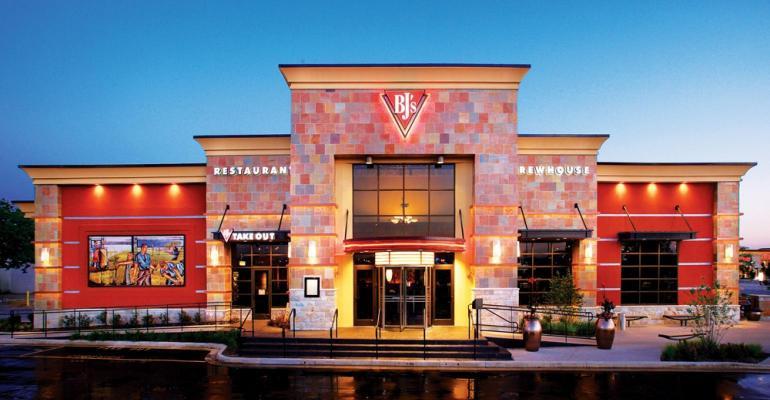BJ's Restaurants Inc.is closely tracking increasing inflation, both on its own costs and its impact on consumer behavior, and is managing the hikes, executives said Thursday.
The Huntington Beach, Calif.-based casual-dining company released earnings for the second quarter, which ended June 28, and said sales had surpassed pre-pandemic levels, beating its prior record set in the second quarter of 2019, according to Greg Levin, BJ's CEO and president.
But the company is keeping an eye on inflation, he said.
In the second quarter, Levin said, “we began to more closely track the underlying patterns of our guests, so we can identify any shifts in our guest behavior early. We measure not only overall sales and traffic trends, but deeper layers such as how often certain categories of guests visit and what is being ordered from our menu, and we review and analyze this data regularly.”
Levin added that to date, through July, the company had not yet seen any measurable change in guest behavior.
“In fact, traffic patterns are following a typical seasonal trend, and our guests are continuing to enjoy the usual amount of appetizers, drinks and desserts in our restaurants,” he said. “And we haven't seen any uptick in the usage of our value offerings, including our Happy Hour and Daily Brewhouse special menus.”
Levin said that if a consumer pullback would occur, BJ’s value proposition would leave to improved performance.
“Furthermore, we expect that any broad decline in demand would be accompanied by relief and input costs, which could benefit margins,” he said.
Levin said BJ’s is approaching pre-pandemic staffing levels in most restaurants, adding 6,000 workers in the quarter, and same-store sales growth in the period was 4.8% compared to the second quarter of 2019.
Tom Houdek, BJ’s chief financial officer, said “this equated to a weekly sales average of more than $118,000 per restaurant. We maintained our off-premise weekly sales average in the low $20,000s while growing dine-in sales to approximately $97,000 in Q2, which was $10,000 higher than the first quarter as we benefited from seasonally stronger sales, improved staffing levels and a more limited COVID impact.
In the week of May that included Mother's Day, Houdek added, BJ’s had its was highest sales week ever at nearly $130,000 per restaurant, beating the previous high sales we set in 2019 by approximately $4,000 on a per-restaurant basis.
Houdek said cost of sales in the quarter was 27.6%, which was 30 basis points unfavorable compared to the first quarter.
“Food cost inflation continued at multi-decade highs and was exacerbated in Q2 by the war in Ukraine, which drove gas prices and other input costs higher in the quarter,” he said. “This food cost inflation equated to approximately 10% higher than the second quarter of 2021 and 2% higher than what we experienced in the first quarter of this year.”
BJ’s has priced its menu items below inflation, the executives said, but it is planning more price increases.
“Our restaurant costs have increased by more than the 4.6% of menu pricing we have added since our November 2021 pricing round when we began to combat this inflationary cycle,” Houdek said. “To help further mitigate the impacts of the inflationary environment, we are now planning an additional menu pricing round of 2% in August, following our 1.4% round in June.”
“In aggregate, our pricing is still behind the current level of inflation,” Levin said. “We will continue to provide strong affordability as we manage our good, better, best pricing strategy. For example, we will continue to provide our guests with our lunch specials starting at $10 in certain markets, as well as our Daily Brewhouse Specials.”
Levin said BJ’s will begin testing a slightly smaller menu focused more on core Brewhouse favorites and key differentiating items later this fall.
“A slightly smaller menu allows us to focus on our guest favorites and improve our operating efficiencies,” he said,
BJ’s also plans to continue work on its catering business.
“We are now testing a more high-touch catering experience to help further expand in the corporate catering channel, which tends to have more recurring orders with higher check average,” Levin said. “In the second quarter, our catering business was up more than 70% over 2021, and we have our sights set on exponential growth from current sales levels.”
For the second quarter ended June 28, BJ’s reported net income of $297,000, or one cent a share, down from $6.4 million, or 26 cents a share, from the same period last year. Revenues increased 13.6% to $329.7 million from $290.3 million.
Same-store sales increased 11.7% over the second quarter of 2021.
BJ’s Restaurants, founded in 1996, has 214 casual-dining restaurants in 29 states. In the quarter, it opened new restaurants in San Antonio, Texas, and Framingham, Mass.
Contact Ron Ruggless at [email protected]
Follow him on Twitter: @RonRuggless





